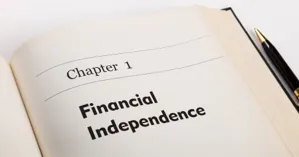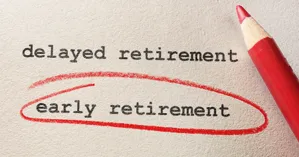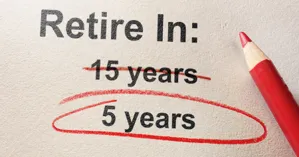
Financial Independence, Retire Early (FIRE) is a movement toward retiring before the traditional retirement age. People adhere to a program of extreme savings and investing. Achieving FIRE before 40 falls into this lifestyle. Establishing an emergency fund is a fundamental step in financial planning, providing a crucial safety net for unexpected situations like job loss or emergency expenses. But how do you do this? What are some realistic steps to take to achieve FIRE before 40?
Understanding Financial Independence
What is Financial Independence?

Financial independence is a state where you have accumulated enough wealth to cover your living expenses without needing to work for a paycheck. It’s not just about having a large sum of money; it’s about having the freedom to make choices that align with your passions and interests. When you achieve financial independence, you can pursue activities that bring you joy and fulfillment, whether that’s traveling the world, starting a new hobby, or spending more time with loved ones. The essence of financial independence is the ability to live life on your own terms, free from the constraints of a traditional 9-to-5 job.
The Benefits of Early Retirement

Early retirement offers a plethora of benefits that go beyond financial freedom. One of the most significant advantages is the ability to spend more time on activities that you love, whether that’s traveling, pursuing hobbies, or simply enjoying more quality time with family and friends. Early retirement also provides an opportunity to recharge and refocus on personal goals and aspirations that may have been sidelined during your working years. Additionally, stepping away from the daily grind can lead to improved physical and mental health, as the stress and demands of a traditional job are reduced. With more time to focus on self-care and personal development, many early retirees find that they are more productive and creative, leading to a more fulfilling and balanced life.
Financial Freedom: A Key Component of FIRE

Financial freedom is a cornerstone of the FIRE movement. It’s the ability to make life choices based on what brings you joy and fulfillment, rather than being driven by financial necessity. Achieving financial freedom means you can pursue your passions and interests without worrying about the financial implications. This state of being provides peace of mind, reduces stress, and increases overall happiness. Financial freedom allows you to live a life that is true to your values and desires, making it a key component of the journey toward financial independence and early retirement.
Three Variations of FIRE
Extreme frugality and aggressive investment are the hallmarks of working toward FIRE. Proponents save up to 75 percent of their yearly income. Typically, once savings have reached 25 times their yearly expenses, they may quit their jobs and retire.
Achieving ambitious savings goals requires making significant adjustments in various aspects of one's financial life.
There are three FIRE variations; you’ll need to determine which one you are and plan accordingly.
1. Fat FIRE
Fat FIRE is for those with substantial salaried jobs who want to save more than the average worker. But they don't want to reduce their current standard of living.
They usually employ an aggressive savings and investment strategy.
2. Lean FIRE
Lean FIRE people are devoted to minimalist living and extreme savings. This requires a restrictive lifestyle. Lean FIRE people generally live on $25,000 or less per year.
3. Barista FIRE
Barista FIRE individuals live between the worlds. They generally quit their nine-to-five jobs but use a combination of part-time work and savings to live a more minimalist lifestyle.
Setting Financial Goals
Define Your Retirement Number: Calculating Income, Expenses, and Savings Rate

Defining your retirement number is a crucial step in your journey to financial independence. This number represents the amount of money you need to save to retire comfortably and maintain your desired lifestyle. To calculate your retirement number, you need to consider your income, expenses, and savings rate.
Start by estimating your annual income in retirement. This includes any pensions, Social Security benefits, or other sources of income you expect to receive. Next, calculate your annual expenses, taking into account housing, food, transportation, healthcare, and other essential costs. It’s important to be realistic and thorough in this calculation to ensure you have a clear picture of your financial needs.
Your savings rate is the percentage of your income that you save each year. A higher savings rate will help you reach your retirement number more quickly. The 4% rule is a commonly used guideline, suggesting that you can withdraw 4% of your retirement portfolio each year without depleting your assets. However, this rule may not be suitable for everyone, especially those planning to retire early. It’s essential to consider individual circumstances and market conditions when determining your retirement number.
By carefully calculating your income, expenses, and savings rate, you can define your retirement number and create a plan to achieve financial independence. This plan will serve as a roadmap, guiding your financial decisions and helping you stay on track to retire comfortably and enjoy the benefits of financial freedom.
How Much Do You Need to Reach Early Retirement Before 40?

There are two factors that go into determining what you will need to retire before 40. They are your anticipated annual retirement expenses and the percentage of your portfolio those expenses make up.
For normal-aged retirees with a 30-year retirement ahead of them, it’s recommended that they only withdraw up to four percent a year from their portfolio.
But for those planning to retire before 40, they’ll need to withdraw less or they’ll run out of money when they’re 60.
To make up for the longer retirement, some early retirees target a two percent to three percent withdrawal rate.
Diversifying one's investment portfolio is crucial to enhance financial security and manage risk. A well-rounded investment portfolio, including stocks, bonds, and real estate, can mitigate risks while aiming for growth.
To figure out how much you’ll need, determine what amount of money you’ll need per year. If you plan to spend $50,000 per year and want to withdraw two percent annually, you’ll need $50,000 divided by 0.02 or $2.5 million to retire.
But how do you earn and save that much money?
Save at Least 50% of Your Salary

You’ll need to save at least 50 percent of your salary each year. As you near your retirement date, it’s advisable to save up to 70 percent.
In addition to saving, consider incorporating passive income as a crucial strategy for achieving financial independence.
This may seem hard, but if you take a hard look at your spending, you’ll find you’re spending money on items you don’t need. Build a budget and stick to it.
Once you’ve built your budget, you’ll need to get your expenses under control. The big ones are:
- housing
- car
- credit cards
- food
Tackle these first while putting money away.
Keep Your Lifestyle in Check

You’ll need to avoid lifestyle creep. That means keeping expenses down and savings up. In other words, only buy what you absolutely need and save the rest.
Don't let your lifestyle be defined by your income. This means when you make $70,000, you spend $70,000. If you get a $10,000 raise you spend it.
Inflating your lifestyle can be a one-way street. It’s hard to go back. Dissociate spending and earnings. What you need to live on shouldn’t be defined by what you earn.
Lifestyle creep happens before you realize it. Remember, if you want to retire, you need to live well below your means.
Invest to Generate Passive Income

You can’t only put your money in a high-yield savings account and expect to retire. You’ll need the compound long-term growth that you can only earn through investing.
Retirement accounts, such as 401(k)s and IRAs, are crucial for achieving financial independence and early retirement strategies. They offer tax advantages, and by maximizing contributions and withdrawals, you can optimize your tax savings.
You’ll need to be as aggressive as you can tolerate. An even stock-to-bond portfolio won’t be effective. That’s because you have a long time frame and need to account for inflation.
You should keep bonds within the right proportion for your current situation. Because you’re in the stock market for the long term, avoid panicking and pulling out of the market if things start to go south.
Go with your risk tolerance. If you can’t stomach the choppiness of a 100 percent equity portfolio, try a different route.
The stock market usually returns about seven percent returns yearly after inflation. It never goes up in a straight line.
Because of this, it’s wise to have a couple of years of expenses in your savings so you don’t have to sell in a down market.
Lower Investment Expenses

When you pay investment fees, you’re not putting that money into your portfolio. Inquire about all fees. If you’re investing in passive index funds, you’ll want your expense ratios to be 0.1 percent or lower.
Retirement accounts offer significant tax advantages that enhance financial growth through compound interest and optimized contributions.
Meet with a Financial Advisor

Before you start this journey, find a qualified and professional financial advisor to help you make informed financial decisions. It’s important to find one who is independent and works for you.
Let them know what your goal is, and they can help you develop a plan. Once you have the plan laid out, it’s important to stick with it.
This goes back to your budget as well.
Downsides to Achieving Financial Independence Before Aged 40

There’s a challenge to saving for retirement when your target is before turning 40. First, you’ll be handicapping yourself.
For most college graduates, their peak earning period is during their 40s. That means they’ll be missing out on a large income and on employer match contributions to a 401 (k).
Retiring that early also means going 22 to 25 years without Medicare or Social Security. Without Medicare, you’ll need to pay for a high-priced healthcare policy. That will also need to be factored into your expenses.
Your full retirement Social Security benefit will be reduced due to lower or no earnings after 40. It is wise to create an account at My Social security (ssa.gov) to compare how much your benefit will be reduced by retiring early.
Conclusion
You can retire before you turn 40, but it will take sacrifice and work. You’ll also need to be highly disciplined. Ensure you understand the downsides to retiring so young. Setting realistic financial goals is crucial to reach financial independence within the framework of the FIRE movement. Concentrate on spending less and investing.



